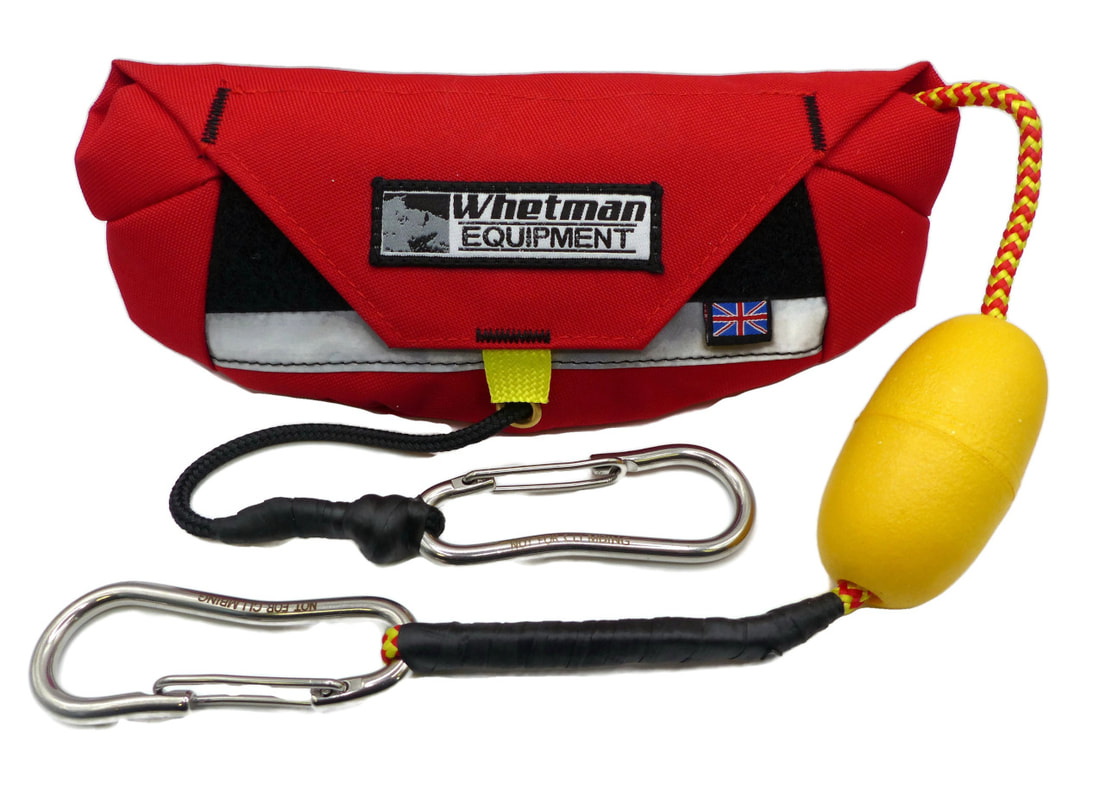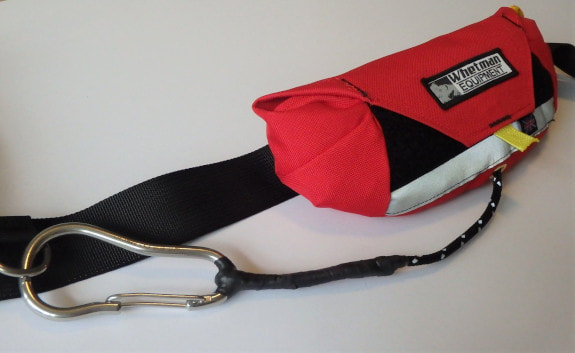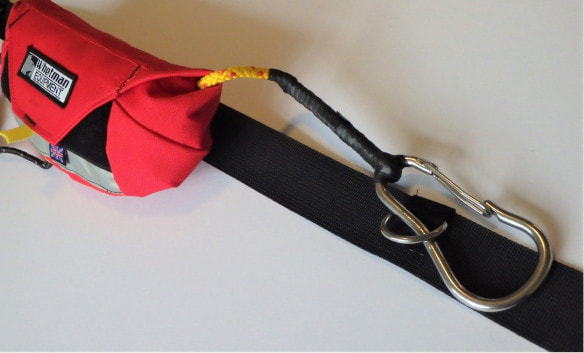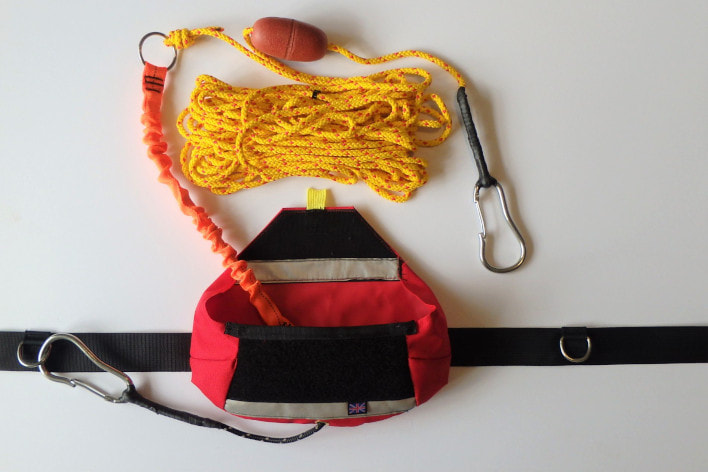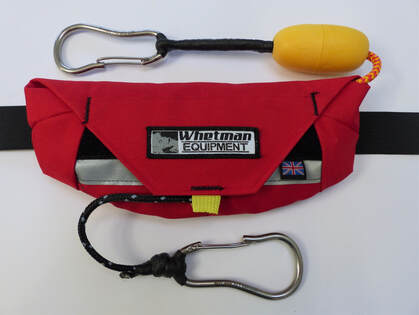|
An original Whetman Equipment product.
Made in the UK, Devon. |
Sea Guide Towline MK11Designed to be used by guides, leaders & coaches.
The priority in making this device was functionality. The user is likely to deploy the device on a regular basis & needs a simple system which can be repacked in rough water and then be deployed again. The bag has two tows:
|
Connectors for Sea Kayak Towing - be informed of the characteristics of this piece of kit - read the article at the base of this page
LEFT SIDE: On the left is the second ultra short tow with connector stowed on the right fixed loop.
RIGHT SIDE: Reach on the right hand side to access the main towline connector stowed on the fixed loop.
RIGHT SIDE: Reach on the right hand side to access the main towline connector stowed on the fixed loop.
|
The two Kraken connectors are positioned further forward on the belt on secure stainless D rings. There are two reflective elements; one on the lower external side and one on the inside which reveals itself when the main tow is deployed. The short tow is reflective rope & the main tow floating 6mm red/yellow. |
Float
The float can travel along the length of the main tow as far as the stopper will allow (usually set about 2 m from the connector) and the stopper position can be adjusted. Therefore if the line needs to thread under several decklines then the float will not prevent this.
The float can travel along the length of the main tow as far as the stopper will allow (usually set about 2 m from the connector) and the stopper position can be adjusted. Therefore if the line needs to thread under several decklines then the float will not prevent this.
Second Tow
The second tow can be used as a contact towline. It has many other uses which includes to connect paddler to kayak if solo or to connect to the main line with a clove hitch enabling a shorter length of main line to be deployed. It can be used to cinch around a paddle shaft & allow it to float free, also useful should a throwline rescue be deployed into a gully; once thrown the throwline end can be clipped into the short tow & the rescuer is then hands free to prepare to tow out the casualty. Another application is should the wearer be assisting from the rocks on a rocky landing in swell he may wish to be held in position on a belay line connected to the short tow to prevent being washed into the sea.
The second tow can be used as a contact towline. It has many other uses which includes to connect paddler to kayak if solo or to connect to the main line with a clove hitch enabling a shorter length of main line to be deployed. It can be used to cinch around a paddle shaft & allow it to float free, also useful should a throwline rescue be deployed into a gully; once thrown the throwline end can be clipped into the short tow & the rescuer is then hands free to prepare to tow out the casualty. Another application is should the wearer be assisting from the rocks on a rocky landing in swell he may wish to be held in position on a belay line connected to the short tow to prevent being washed into the sea.
To repack
The bag is designed so that the cover will stay upright & open and the bag remains flared open to receive rope. Spin the bag to your front and gather the rope in very short loops in one palm and count the number of loops. When you count to approx 25 laps then you will have the majority of the rope in your palm. Stuff the rope in one action into the bag, close the cover and clip the connector to the D ring. With practise this is possible to complete within 60 seconds. Whilst counting loops you will be able to look around and keep good balance; there is no need to gaze down at the gathering loops of rope!
The bag is designed so that the cover will stay upright & open and the bag remains flared open to receive rope. Spin the bag to your front and gather the rope in very short loops in one palm and count the number of loops. When you count to approx 25 laps then you will have the majority of the rope in your palm. Stuff the rope in one action into the bag, close the cover and clip the connector to the D ring. With practise this is possible to complete within 60 seconds. Whilst counting loops you will be able to look around and keep good balance; there is no need to gaze down at the gathering loops of rope!
Belt Safety Advice
Adjust the belt length to fit your waist so that the large main quick release buckle is central in front and the towbag is aligned central to the rear. To adjust use the belt slider and also use the webbing through the main buckle. Adjust whilst wearing kit you will be using on the water. Once the belt is adjusted to fit you there will be excess webbing tailing out of the main buckle. It is highly recommended to cut the excess tail so that a very short length tail remains: tail length approx 8cm
Adjust the belt length to fit your waist so that the large main quick release buckle is central in front and the towbag is aligned central to the rear. To adjust use the belt slider and also use the webbing through the main buckle. Adjust whilst wearing kit you will be using on the water. Once the belt is adjusted to fit you there will be excess webbing tailing out of the main buckle. It is highly recommended to cut the excess tail so that a very short length tail remains: tail length approx 8cm
Cut the tail using sharp scissors or a hot knife. Make sure the end edge is melted and flat so there are no rough burrs. A short tail will allow a much quicker release of the belt in an emergency.
Pull and Punch
To deploy an effective quick release pull and punch forward the release toggle and with a short tail the belt will quick release.
Pull and Punch
To deploy an effective quick release pull and punch forward the release toggle and with a short tail the belt will quick release.
Training & Practise
As with all rescue kit training & practise is essential before use to ensure correct & safe application of the device.
As with all rescue kit training & practise is essential before use to ensure correct & safe application of the device.
Connectors for Sea Kayak towing.
There are a variety of connectors used for towing sea kayaks and all have their benefits and pitfalls. There is not a perfect connector yet available for this task; each one has its limitations and it is up to the paddler to make an informed choice of what to use and then test and practise using it so as to become competent in its deployment & appreciate what it can/cannot do. This text is to assist in giving that information & we also suggest go chat to an experienced sea kayak coach!
Sea kayaking is an assumed risk activity and your rescue kit is there to help you manage that risk. However on rare occasions it may malfunction; therefore your exposure to risk should consider this & always have a back up. The connector or karabiner is a critical aspect of the sea kayak towing system. Regarding the connectors generally used they all are snag free with no hook on the nose which could snag the deckline. Most sea kayak coaches recommend clipping from underneath the deckline to reduce the chance of the clip disconnecting. All of these clips are snapgates hence they snap close on a spring and can be opened and closed very quickly; brilliant for a quick connection on a lumpy sea. This characteristic is also a potential cause of failure and can result, on rare occasions by chance, in the snapgate unclipping entirely from the deckline leaving the towed kayak at the mercy of Neptune’s wrath.
Snapgate disconnection can occur if the kayak is thrown around and lurches back and forward, up and down causing the connector & line to be tossed & twisted in all directions. With wiregate clips such as the Kraken stainless clip (and most other wiregate clips) if they run alongside the deckline on rare occasions the rope itself can catch on the gate and drag it open & disconnect. This is more prone to occur if the decklines are tight and made of cheap polypropylene rough braided lines rather than the smoother polyester decklines. So if you use these clip types practise clipping to the very front of the bow to prevent this. The benefit of wiregate clips is the spring is very simple and will not jam or corrode given it is created by eccentric loading of tensioned maintenance free stainless steel – clever stuff! Lets compare this to a connector with a solid gate. These clips have an internal tube with a traditional spring which can jam with dirt and salt crystals; so although these are less likely (still possible though) to disconnect from a line, they may jam open or closed when you need them most! Even when scrupulously maintained these clips can fail as a result of exposure to a marine environment. There are also some plastic clips used and issued on products; they are quite small & chunky with a leaf type gate and are light and relatively cheap. The maximum strength of these is much lower than a metal clip so consider what types of situations you will be in and make an informed decision. Some coaches will insist on these being replaced before launching!
In rock climbing snapgates are recognised as a risky connection and are not used for critical rigging; that task is for a screwgate connector; a threaded collar is screwed over the gate to stop it opening. The screwgate connector is another option to consider. If you intend to be in demanding high risk situations where a towline connection must be super reliable then a screwgate clip is the tool for the job. Stop! Its not that simple of course given the collar could jam with sand/salt/corrosion, and also the spring could fail, so if you decide on one of these be extremely vigilant with maintenance and lubrication.
So as yet there is no perfect connector and hopefully this information will help you decide what to use and recognise the limitations of your choice. My company is striving to develop new ideas for a more versatile connection system and we haven’t yet got the perfect design so watch this space!
Steve Whetman
Whetman Equipment
There are a variety of connectors used for towing sea kayaks and all have their benefits and pitfalls. There is not a perfect connector yet available for this task; each one has its limitations and it is up to the paddler to make an informed choice of what to use and then test and practise using it so as to become competent in its deployment & appreciate what it can/cannot do. This text is to assist in giving that information & we also suggest go chat to an experienced sea kayak coach!
Sea kayaking is an assumed risk activity and your rescue kit is there to help you manage that risk. However on rare occasions it may malfunction; therefore your exposure to risk should consider this & always have a back up. The connector or karabiner is a critical aspect of the sea kayak towing system. Regarding the connectors generally used they all are snag free with no hook on the nose which could snag the deckline. Most sea kayak coaches recommend clipping from underneath the deckline to reduce the chance of the clip disconnecting. All of these clips are snapgates hence they snap close on a spring and can be opened and closed very quickly; brilliant for a quick connection on a lumpy sea. This characteristic is also a potential cause of failure and can result, on rare occasions by chance, in the snapgate unclipping entirely from the deckline leaving the towed kayak at the mercy of Neptune’s wrath.
Snapgate disconnection can occur if the kayak is thrown around and lurches back and forward, up and down causing the connector & line to be tossed & twisted in all directions. With wiregate clips such as the Kraken stainless clip (and most other wiregate clips) if they run alongside the deckline on rare occasions the rope itself can catch on the gate and drag it open & disconnect. This is more prone to occur if the decklines are tight and made of cheap polypropylene rough braided lines rather than the smoother polyester decklines. So if you use these clip types practise clipping to the very front of the bow to prevent this. The benefit of wiregate clips is the spring is very simple and will not jam or corrode given it is created by eccentric loading of tensioned maintenance free stainless steel – clever stuff! Lets compare this to a connector with a solid gate. These clips have an internal tube with a traditional spring which can jam with dirt and salt crystals; so although these are less likely (still possible though) to disconnect from a line, they may jam open or closed when you need them most! Even when scrupulously maintained these clips can fail as a result of exposure to a marine environment. There are also some plastic clips used and issued on products; they are quite small & chunky with a leaf type gate and are light and relatively cheap. The maximum strength of these is much lower than a metal clip so consider what types of situations you will be in and make an informed decision. Some coaches will insist on these being replaced before launching!
In rock climbing snapgates are recognised as a risky connection and are not used for critical rigging; that task is for a screwgate connector; a threaded collar is screwed over the gate to stop it opening. The screwgate connector is another option to consider. If you intend to be in demanding high risk situations where a towline connection must be super reliable then a screwgate clip is the tool for the job. Stop! Its not that simple of course given the collar could jam with sand/salt/corrosion, and also the spring could fail, so if you decide on one of these be extremely vigilant with maintenance and lubrication.
So as yet there is no perfect connector and hopefully this information will help you decide what to use and recognise the limitations of your choice. My company is striving to develop new ideas for a more versatile connection system and we haven’t yet got the perfect design so watch this space!
Steve Whetman
Whetman Equipment

